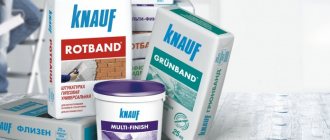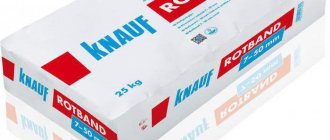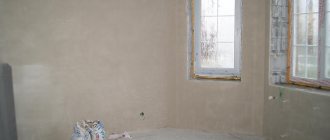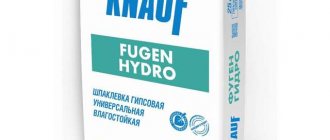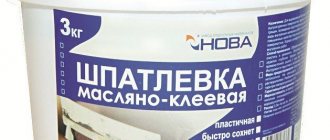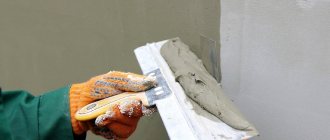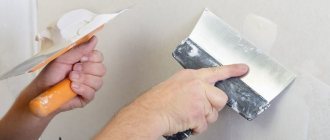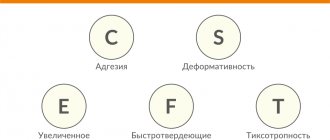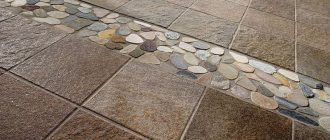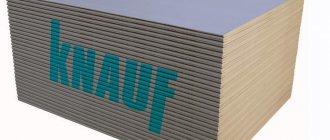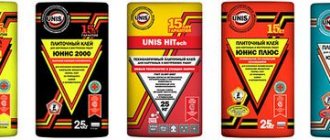Finishing work, including preparing surfaces and even giving their relief unusual shapes, cannot do without putty. The market is rich in choice, but many consumers are attracted to Knauf putty. The company offers a wide range of putty materials from powder mixtures to ready-made emulsions. Let's look at the most popular varieties. It is worth noting that all putty mixtures from this manufacturer contain adhesive ingredients.
Gypsum putties
KNAUF putties based on gypsum
Gypsum putties are dry putty mixtures based on gypsum.
They are intended for surface puttying of concrete and tongue-and-groove slabs, leveling gypsum and cement plasters, sealing joints of plasterboard (GKL) and gypsum fiber (GVL) sheets. In addition, gypsum-based putties are used when installing gypsum tongue-and-groove slabs (GGP). Typically, gypsum putties are used indoors with dry and normal humidity conditions. In the kitchen and bathroom they should only be used with moisture protection. For example, if waterproof paint is later applied to the surface.
Gypsum putties
KNAUF-Fugen
KNAUF-Uniflot
KNAUF-Rotband Finish
KNAUF-HP Finish
KNAUF‑Satengips
KNAUF-Unichard
KNAUF-Eisspachtel
KNAUF-Fugen Hydro
KNAUF-Basis
KNAUF-Safeboard Spachtel
The main advantages and disadvantages of gypsum putties
Gypsum putties have fairly high strength, quickly gain strength, are economical to apply, dry quickly and practically do not shrink, which allows them to be applied in a layer of up to 5 mm and used for sealing joints of plasterboard and gypsum fiber sheets.
At the same time, gypsum putties lose their performance properties upon prolonged contact with moisture - the gypsum softens and loses strength, which can cause the surface to become deformed.
The recipe for KNAUF gypsum putties was developed by German specialists with an eye to Russian conditions. The company ensures a high level of product quality through control of the entire production chain - from the extraction of gypsum to the shipment of finished products for sale or to construction sites. The use of Knauf gypsum-based putties makes it possible to prepare a Q3 quality surface.
Gypsum putties can be divided into two types - for continuous putty and for sealing joints.
KNAUF gypsum putties for continuous puttying
KNAUF's assortment for surface puttying includes gypsum putties KNAUF-Rotband Finish, KNAUF-Satengips and KNAUF-HP Finish. They are similar in grain composition, but differ in the amount of polymer additives.
The most popular product is KNAUF-Rotband Finish. Thanks to its fine grain, high elasticity and easy application, it allows you to create a smooth surface, ready for finishing with paint or wallpaper.
Compared to KNAUF-Satengips and KNAUF-HP Finish putties, it has a larger “platform” (time from beginning to end of setting) - other KNAUF gypsum putties for continuous puttying are more demanding on the level of training of the master.
KNAUF-Rotband Finish
KNAUF‑Satengips
KNAUF-HP Finish
KNAUF gypsum putties for sealing joints
To seal joints between plasterboard and gypsum fiber sheets, KNAUF recommends using KNAUF-Uniflot and KNAUF-Fugen gypsum putties.
KNAUF-Uniflot is a putty based on high-strength gypsum, produced only in Germany.
It has increased strength, which makes it possible to seal joints of gypsum board sheets with a semicircular thinned edge (PLUK) without the use of reinforcing tape.
Thanks to this, installation becomes easier (since you do not need to wait for the first layer to dry and apply the second), and construction time is reduced.
KNAUF-Fugen is a universal putty. KNAUF-Fugen is resistant to cracking, minimal shrinkage, and high.
Thanks to a special composition based on gypsum and polymer additives, it can be used for sealing gypsum board and gypsum fiber board joints, continuous puttying (in layers up to 5 mm), installing PGP, sealing small chips and gluing stucco.
Thus, most pre-finish leveling work can be completed with one composition.
How to work with gypsum putties
For surface puttying, gypsum putties are recommended to be used in layers of 2-3 mm, since they give the least shrinkage compared to polymer compounds. If there are large uneven walls, it will be more rational to pre-level them with plaster or using complete cladding systems.
Preparing the base
Gypsum, like other putties, are applied to a pre-primed surface of solid bases - gypsum plasterboard, gypsum plasterboard, GGP, gypsum and cement plasters, concrete and other materials. The surface of the base must be cleaned of dirt and dust and primed.
Preparation of the solution
Dry putty mixtures are poured into a container with clean cold water and evenly distributed over the surface. If you add water to the mixture, the finished solution will likely be lumpy, making it difficult to work with. For detailed proportions, data on the viability of the solution and other indicators, see the instructions for each composition.
Application
With continuous puttying, the putty is applied to the surface in an even layer and leveled with a wide spatula or trowel. After spreading the material, the surface should be smoothed, removing excess material and filling the depressions. The technology for puttying joints varies depending on the materials and the shape of the edge.
Source
Conditions and procedure for performing work
Before starting work using Knauf-Fügen putty, care must be taken to create suitable conditions. Any master needs to know this, especially beginners. The optimal temperature ranges from +10 °C to +30 °C.
Processing of plasterboard sheets should only begin after all “wet” processes have been completed, which lead to changes in temperature and humidity levels in the premises. This includes installation of self-leveling floors, plastering of walls and ceilings, installation and dismantling of windows (especially from autumn to winter).
You need to start putting putty when the surface to be treated is completely dry. Otherwise, linear deformation of the gypsum board and, as a consequence, cracking of the coating cannot be avoided.
It is also prohibited to add other components to the solution, otherwise the quality of the putty will decrease, and significantly! The manufacturer produces putties with a specially selected composition. It is undesirable to use a thickened mixture, as well as dilute it with water - this will not return the original properties.
Preparing the surface for puttying
Preliminary surface preparation is strictly necessary and neglecting this stage is highly discouraged. The first thing you need to do is get rid of the old finish - wallpaper, plaster. The base is thoroughly cleaned of other contaminants - mold (if any), grease deposits, dirt, dust. After cleaning, it is necessary to treat with a primer depending on the type of walls.
Processing the rough coating is a mandatory stage of the work.
Plasterboard structures
The frame is assembled according to technology, which avoids sagging of plasterboard sheets when creating ceilings or deformations of cladding and partitions. The sheets must be firmly fixed to the frame, in which the pitch of the fasteners plays an important role:
- 170 mm – ceilings;
- 250 mm – partitions.
The sheets themselves must be laid out in a staggered manner. The displacement of seams also has its own weight:
- 400 mm relative to vertical;
- 150 mm relative to horizontal.
The screw caps are covered with putty (Knauf-fugen). The end parts of the sheets should be cut at an angle of 22.5°, which is effectively achieved with a special tool (edge plane). Also, the ends must be primed with a deep penetration compound.
At the end of the preparatory stage, a primer is applied to the surface. You can use a brush, roller, spray. Wait until it dries - each type of primer has its own duration:
- Tiefengrund – 3 hours;
- Betocontact – 12 hours.
It is important to ensure that the treated surface does not become dusty again.
Seams and small recesses between sheets are coated with the composition using a spatula
Dilution of putty
Most beginners make a number of mistakes while still at the stage of preparing the mixture for surface treatment. Do not allow air to get in when mixing the mixture. For this reason, it is not advisable to use mixers or other mechanical devices. It is better to dilute portions manually. At the very least, the mixer speed should not exceed 300 - then air will not penetrate into the mixture during the mixing stage.
The kneading procedure has a number of features:
- On average, 0.8 liters of water are taken per kilogram of dry mixture. The exact proportions are indicated on the label for each Knauf product.
- The dry composition is carefully and gradually poured into a container of water for proper impregnation.
- When the mixture is poured, wait 2-3 minutes. This time is enough for the mixture to become saturated with water. Only then start stirring. If you start right away, you will not be able to achieve a uniform structure, and the putty will lose its technical characteristics.
- The temperature of the water for mixing the dry mixture plays an important role. Indicators should be kept within +5 °C to +30 °C. Due to warmer water, the moisture resistance of the mixture deteriorates and subsequently the coating will begin to crack after drying.
- It is advisable to mix the mixture manually with a spatula. Using a mixer at low speeds is important when you need to prepare a lot of solution - it is very difficult to knead such a volume with your hands (even with a shovel).
- The ready-to-use mixture should have a uniform, creamy consistency. Initially, the solution seems liquid during mixing, but you cannot deviate from the proportions and add more dry mixture. After some time, the consistency will come to the desired form.
Attention! You should not throw the remaining putty back into the container with the prepared mixture. This shortens the lifespan of the composition, which quickly renders it unusable.
The rate of consumption is affected by the type of finishing work
Why do you need putty?
It can be used to level surfaces made from a variety of materials—everything can be puttyed. It's just a matter of choosing the right material.
What can be treated with putty:
This material has proven itself in working with slopes (doors and windows), when finishing arches, etc. Start putty is not much different in appearance from the finishing mixture, but has a denser structure and is cheaper.
Characteristics:
Nowadays, there are mixtures for both exterior and interior decoration. This must be taken into account. If facade putty is used for interior decoration, then such a coating will not last long, and the repair will soon need to be done again. And if you take the mixture for interior work and putty it on the facade, it will become unusable even earlier.
In both cases, the result is the same: wasted time, material and money. In addition, the old coating will have to be completely removed, which is not a very pleasant task, considering the amount of dust that will be released during this work. To prevent this from happening, you need to consult sellers and managers of construction markets, and also carefully read the instructions on the packaging.
If you have reason to believe that, due to your inexperience, you can ruin the solution due to little experience in such work, because you are doing it too slowly, then it is better to purchase a product marked “max putty.” It is better to make less solution at first so that you have time to use it before it hardens.
Recommendations for using Knauf putty
- Try to follow the instructions on the package.
- Do not add a lot of water at once; it is better to add it little by little than to immediately ruin the mixture or throw away the frozen block.
- Wait until completely dry before proceeding with further work.
- Store powder mixtures tightly closed in a paper bag and only in a dry, warm place.
- Do not try to re-thread cured putty as this may affect the smoothness.
- Do not add foreign substances or agents to the solution.
- Apply a reasonable coat of putty to complete the drying process and prevent chipping.
- Consider the purpose of the room when choosing materials.
- Look at the expiration date on the packaging and ask the seller for a certificate of conformity.
- If the material behaves strangely, most likely the storage technology was violated or you came across a fake.
VIDEO: How to recognize a fake Knauf Rotband
Composition and technical characteristics
Both the base (starting) and finishing putty have a similar composition. The main differences are the viscosity of the consistency and the size of the filler fraction.
Differences in composition:
Cement starting putty contains different types of cement. They are characterized by different colors, with different saturations. A distinctive feature of cement putty is its resistance to moisture. If a large layer is applied, damage may occur due to drying. They are best used for finishing buildings, facades, bathhouses, kitchens and other concrete surfaces.
Gypsum putty for walls – white. This is due to the presence of gypsum as the main structural element. Distinctive features are elasticity and shrinkage when drying. Due to the presence of gypsum in the composition, drying time is much shorter than other types.
Polymer – based on polymer compounds. Colors are light brown and white. The main feature of this type is its long service life and ease of use. It is easy to use and has unique construction properties.
Consumption per 1 m2
Material consumption primarily depends on the type of surface.
What affects material consumption:
Depending on the components used in the putty, the consumption may also depend. For example, gypsum starting soil requires less consumption and dries quickly.
On a flat surface, soil consumption is 800-900 gm3. If the surface is as uneven as possible, with large protrusions, then the consumption increases significantly, and reaches 8 kg per m3.
Important. The layer density should not be more than 10 mm, otherwise the efficiency will be reduced. There is a possibility of destruction of the structure, since the layer will not support the weight and will collapse.
Manufacturers who create starting putty usually use:
The proportions depend on various nuances, as well as on which manufacturer produced the particular putty material. Today, many specialize in the production of basic putty, and so on.
When choosing the right material, you can read consumer reviews and review ratings. It is recommended to give preference to well-known manufacturers who have gained a good reputation.
Materials that contain a particularly large amount of cement are very resistant to liquids. For this reason, they are well suited for both interior and exterior finishing work. They are used to treat surfaces in rooms with high humidity. However, such materials also have disadvantages: they are distinguished by a rich gray color, which is very difficult to hide with thin wallpaper, and they also shrink significantly after some time.
Dry gypsum putties have a beautiful white color and are more aesthetically pleasing. However, such materials should not be used in rooms with high humidity.
Putty materials based on polymer binders are very popular. These are, for example, acrylic materials. Such putties have the following advantages:
Homemade
If you need to save money on purchasing branded starting putty (Knauf, etc.), you can make this type of building mixture with your own hands. Let's look at how to prepare this or that putty with your own hands in more detail:
Let us remind you that the putty consumption here will be greater than that of purchased ready-made mixtures.
Ready mixes
Start putty is sold ready-made. Such ready-made mixtures come in the following types:
The following ready-made mixtures can also be used for finishing metal, wood and other structures:
Each ready-made solution of starting putty has its own consumption, which should be remembered when choosing it in the store. The thickness of the layer applied to the surface also affects the consumption. These two parameters should be taken into account when determining the volumes of finishing material required.
Commercially available varieties
Depending on the location where the material is applied, you should choose the appropriate type of putty. The manufacturer offers putty for gypsum fiber sheets - Knauf Fugen G.V. and material for work in places with high humidity - Fugen Hydro.
The first option is intended for sealing seams and minor irregularities. In terms of its composition, this mixture has almost the same composition as the universal remedy. The differences lie in the permissible thickness of the applied layer and the consumption of the prepared substance.
To cover seams and joints, up to 600 grams of mixture is required. With a continuous application of raw materials 1 millimeter thick, up to 1.2 kilograms will be required. Otherwise, the material has similar characteristics to the universal mixture.
The second material contains special additives that allow it to be used:
- For the purpose of gluing moisture-resistant drywall to a flat surface, as well as puttying and gluing gypsum raw materials.
- For filling joints between sheets of plasterboard in damp rooms.
- As an element for filling cracks or depressions in concrete floors.
- For filling and installation of tongue-and-groove moisture-resistant slabs.
The remaining characteristics are no different from the universal composition of Fugenfüller putty. The maximum thickness of the applied layer should not exceed 5 mm. A moisture-resistant analogue will cost twice as much as universal products.
Advantages and disadvantages
Starting soil, or base soil as it is called, has positive and negative characteristics. Basic because it is required for almost all finishing works. After the base primer, the finishing primer is applied.
curtains lying on the floor photo
There are practically no disadvantages to starting soil. The relatively high price of popular manufacturers is one of the main problems. Consumers often save money by not purchasing a quality product, after which problems associated with destruction begin.
How to choose?
If you are aiming to obtain coatings that will last as long as possible and will not cease to be aesthetically pleasing over time, use materials from the same manufacturer (and belonging to the same series) in the same room. When planning to purchase putty, first find out the expiration date and read the instructions.
Do not use putty solutions for interior finishing work that are intended for treating external surfaces. Otherwise, cracks may appear on the surface, after which you will have to make repairs again.
If you are a beginner, but want to handle everything yourself, opt for Maxi materials. Putties with this mark harden for quite a long time, so you will have the opportunity to carry out finishing work without undue haste.
Preparing the mixture
If you decide to use dry putty, you must properly prepare its solution. To avoid lumps, you need to pour the putty into water, rather than pour it in. The water should be cool or room temperature.
Use a construction mixer to simplify the process of preparing the mixture. There is a rule among master finishers, according to which an analysis is carried out to determine the readiness of the mixture.
Hook a small amount of the resulting solution with a spatula and turn the tool vertically: if the putty does not slide off it, it is ready. But if it flows off the spatula, you need to add a small amount of dry mixture to it.
After final stirring, you need to pause for 2-3 minutes. It will ensure the completion of all chemical reactions in the solution.
Profile for drywall: dimensions, types, purpose, features of selection and application (95 photos)Non-woven wallpaper - features of choice and recommendations on how to properly glue semi-synthetic wallpaper
- Which brick is better for building a house?
Characteristics of Knauf starting putty
Recently, Knauf starting putty has been increasingly used for interior work. This is a high-quality product, manufactured using German technologies and meeting international quality standards. This type of putty is a gypsum version; it is intended for repair work in rooms with normal humidity.
Knauf brand putty is considered an environmentally friendly product, so it is harmless to human health, thus it can be used to carry out work in children's rooms and medical institutions.
The putty mixture in buckets is a ready-made composition that can be used by anyone. The starting version of Knauf putty can be purchased in bags of varying weights, starting from 5 kg. The positive qualities of the material include:
The only disadvantages of starting putty for walls are that it hardens quickly, as well as the inability to create a sufficiently thick and high-quality layer. The manufacturer regulates the maximum layer of putty to be applied as one and a half centimeters. It is quite enough to hide visible defects and cracks in walls or ceilings.
This putty cannot be used for exterior work, since the gypsum included in its composition does not tolerate moisture.
Product varieties
Knauf starting mixtures are available in several types:
The first type is considered universal, as it is suitable for application to concrete, brick, plasterboard and even polystyrene foam walls. This option can be used for renovation work in bathrooms and kitchens. Knauf Start putty has a number of advantages, including:
If you follow all the rules described in the instructions, you can get a fairly smooth wall on which you can apply the finishing layer.
Rotband putty can be distinguished in three shades: white, gray and pink. The thickness of the applied layer can vary from 5 to 30 mm. The time for complete drying of the material is usually 7 days. Sold only as a dry composition in paper packaging.
Even if water gets on the wall, the putty will not slide off and will retain all its quality characteristics. Rotband material also has high fire resistance, which proves the safety of the material, and good thermal insulation.
The third type is intended for application only on vertical planes, that is, on walls, because the composition does not contain an adhesive base. The putty simply will not stick to the ceiling, even with a high-quality primer layer. Another significant difference is the fairly thick application layer - it can be applied up to 50 mm. With such dimensions, the composition fits well on brick and concrete walls.
Features of use
Knauf brand Fugenfüller (Fugen) putty is stable after drying and does not form cracks. Consists of natural eco-friendly materials that are harmless to human health.
Characteristics:
- The manufacturer's recommended layer thickness is 1-3 mm. If used to seal gypsum board joints, it is applied twice;
- The consumption when working with different surfaces is different: to process drywall joints and screw heads you will need 0.25 kg; consumption for tongue-and-groove tiles – 1.5 kg/m²; continuous gypsum board coating – 0.8 kg/1 m² with a layer thickness of 1 mm; leveling plastered walls (consumption depends on the level of roughness) – 1 kg/1 m².
Extra options:
- Fraction size – no more than 0.15 millimeters;
- Compressive strength – 3.0 MPa;
- The level of bending strength is 1.5 MPa;
- To obtain a finished solution weighing 1.3 liters, you will need 1 kg of the powdery contents of the package.
The mixture is available in three varieties:
- regular "Fugen";
- "Fugen GV";
- Fugen Hydro.
Technology of working with putty
In any work you must follow certain rules. This is when the quality of work and long service life of the surface are ensured. Starter putty is no exception to the general rules.
Before puttying you must:
It is important to note that the primer must be compatible with the putty in composition. The finished putty should be thoroughly mixed before use. If it was stored for a long time, its components separated. Mix using a mixer.
Gypsum and cement mixtures are sold in dry form. Water must be added to such materials in strictly defined proportions indicated on the packaging. To do this, first water is poured into the container in the required quantities, and only then the mixture is poured in with continuous stirring. The finished solution is kept for up to 15 minutes and mixed again.
Tips for applying the material
As already mentioned , to increase adhesion (adhesion of the mixture to the surface being repaired), the walls must first be primed with a deep penetration primer so that the thick layer of coating does not peel off (swell) over time. Proper preparation of the walls guarantees a successful renovation.
When the walls in a room are not very smooth, as is often the case, this can be quite easily eliminated with starting putty if you have certain skills in working with the material. All defects can be corrected. To make large planes (walls, ceilings) perfectly flat, you need to use a special tool - a rule.
Only after you have finished working with the putty, sanded the wall and achieved a smooth surface, can you begin to cover it with the finishing material.
Briefly about the product
Putty is a composition containing substances that form a film, filling irregularities, crevices and cracks. Used as a preparatory stage for interior and facade work. They come in the form of dry mixtures and ready-to-use without mixing the solution. This affects the price and shelf life. Ready ones can be frozen if the entire package is not used immediately.
The entire product line is divided according to two criteria:
- compound;
- appointment.
Based on their composition, there are gypsum, cement and polymer mixtures, each of which has its own characteristics. Thus, the gypsum composition is the cheapest, but is not “friendly” with water - it is used only in those rooms where there is not and will not be a humid environment. Cement ones are several orders of magnitude stronger, but they shrink significantly. Polymer ones perform best, but they are also more expensive.
According to their intended purpose, the market offers: basic (starting), finishing (decorative) and universal. According to the name, the first is applied to plastered walls as a preparation, the second creates a perfectly flat, smooth surface, and the third, universal, can be used to seal large flaws on any surface.
Putty from Knauf: start and finish of finishing work
Putties under the Knauf brand: starting, finishing and universal - are an integral part of any construction. This German company has been producing finishing materials for a long time and has managed to gain recognition throughout the world. Major renovations in an apartment inevitably involve leveling the walls. To do this you will need starting and finishing putty. The first is necessary for preliminary (rough) preparation of the base, the second - for the final stage. Let's figure out why you should give preference to Knauf, because putties are presented in a fairly wide range on the construction market.
layers of soft roofing with insulation
Types of putties: their features, pros, cons and application
Table of contents of the article: Types of putty: varieties, their features and purpose Which putty is better: subtleties of choice for a quality result How to prepare putty for use: step-by-step instructions Putty
is an excellent way to level out minor unevenness on any surface, since modern technology makes it possible to produce such compositions for practically any materials.
They putty literally everything that needs to be leveled - metal, brick, concrete, wood and even plastics. On this site we are talking about construction, which is why we will talk about construction putties. In this article together with the site stroisovety.
org we will study the types of putties and get acquainted with their features and applications.
Types of putty for walls
Types of putties: varieties, their features and purpose
In construction and repair, three main types of putties are mainly used - cement-based mixtures, gypsum putties and so-called ready-made compounds, which are mainly used for final finishing of wall and ceiling surfaces.
- Cement-based putty.
This type of putty can be called universal - they are used with equal success both indoors and outdoors. The main advantages of this type of putty include high strength and excellent resistance to moisture - they can withstand even prolonged exposure to 100% humidity. It is for this reason that their scope of application is mainly limited to leveling external walls. If we talk about the disadvantages of cement-based putties, then we can only mention its poor workability - it is quite difficult to clean it using conventional abrasive materials. In this regard, it is used as a rough finishing material when preparing walls for the application of finishing decorative coatings such as decorative plaster, tiles and other similar materials, which, due to their rigidity, easily hide its rough structure. Cement-based putty photo - Gypsum putties.
These types of putty for walls and ceilings are used exclusively indoors - gypsum is destroyed by prolonged exposure to moisture, so it is not used outside. There are two subtypes of such mixtures for leveling surfaces - these are starting and finishing mixtures. Based on their name, it is not difficult to imagine the scope of their application. Starting putty has a rough structure and is used to level surfaces whose deviation from the plane exceeds 5 mm. As for finishing mixtures, they are used for finer leveling. As a rule, these types of putties for interior work are used in pairs - first, the walls are pre-leveled using starting mixtures, and then the resulting result is brought to standard using finishing putty. Even if we are talking about puttying drywall, it is still better to use two types of mixtures - in such a situation, the seams are sealed using the starting putty, and the rest of the surface is finished with the finishing putty. Gypsum-based putty photo - Ready-made compositions based on acrylic. These types of materials can hardly be called finishing putty - to be precise, the name super-finish or even jewelry putty is more suitable for them. It is applied to the surface in a layer of no more than 1 mm and is used in most cases for fine work - it is used to complete the final finishing of walls and ceilings prepared for painting. When applied correctly, this material produces an almost glossy surface.
Which putty is better: subtleties of choice for a quality result
In most cases, putty is sold in tightly sealed bags, and there is no way to examine their contents without looking inside.
How then? You have to trust the experience, practice of specialists and the opinions of experienced people. By and large, you can apply even the worst putty to the wall, but you understand that the result may be of poor quality.
If this happens, the mixture is replaced with a better one and the last layer is applied with a quality compound.
To be specific and answer the question of which putty is best to putty on walls, the answer will be simple, but incomprehensible to many – soft. Such compositions include the Turkish putty “Eurogypsum”, mixtures of the companies Knauf and Henkel.
If we talk about domestic products, then we can highlight the putties “Starateli”, “Volma” and “Ural building mixtures”.
The quality of these products is excellent and the most important thing is that these putties have been tested by time and by more than one generation of craftsmen.
Which putty is better
There is another way to check the quality of the putty.
In many construction stores it is sold by weight - you can purchase one-, two-, or five-kilogram packages and simply try it before making a bulk purchase.
The only “but” in this whole story is that in this way they sell mainly the cheapest mixtures, which are not popular and are simply lying around in the store.
How to prepare putty for use: step-by-step instructions
Almost all types of putty are sold in stores in the form of a dry mixture - the exception is acrylic, which is completely ready for use, and to start using it, you just need to mix it. In this regard, dry mixtures are slightly inferior to them - they require proper preparation. How to prepare dry putty mixture for application? This is done quite simply.
- Pour water into a clean bucket in the amount of 1/3 of the existing capacity. We pour cold water, since hot water speeds up the hardening process of the putty.
- Pour the dry mixture into the water. It’s difficult to talk about the required quantity - it all depends on the desired thickness of the finished putty. For example, to apply the final layer, it is better to prepare a thinner solution than to putty the walls with the first layer. In general, based on practice, enough dry mixture is poured in to form a slide 100 mm high above the water. If it is not enough, then at the first stage it can be added.
- We take a construction mixer and perform initial mixing, the purpose of which is to soak the dry mixture with water.
- Leave the composition alone for about five minutes, during which time the gypsum powder should thoroughly soak. If this is not done, lumps will form in the putty.
- After five minutes, use the same mixer to mix the composition until a homogeneous mass is obtained and again leave for a couple of minutes alone.
Then we repeat the mixing procedure. How to prepare putty
In a good way, the putty takes a long time to prepare - it is mixed in several batches. A person with experience sees its condition and knows when to start working. And without experience, you will have to rely on hours or advice from specialists who say that you need to mix in at least three passes, each of which lasts 3-5 minutes.
In conclusion, considering the issue of types of putty, I want to give a couple of small tips on its use, or rather there is only one advice, but two consequences follow from it. Firstly, you should not prepare putty in large quantities, since it thickens over time and it becomes almost impossible to putty with it.
Secondly, you should not re-dilute thickened putty, especially when it comes to applying the finishing layer - it comes in lumps and begins to thicken twice as fast.
Just throw the thickened mixture into the trash, thoroughly clean and wash the bucket and mix a new portion of the solution, but in smaller quantities.
Author of the article Alexander Kulikov
Source: https://stroisovety.org/vidy-shpaklevok/
Knauf Rotband
The best option for finishing interior spaces. The mixture can be called universal. It is suitable for leveling concrete, brick and polystyrene foam bases, and can be applied to walls and ceilings. In addition, the putty is impervious to damp environments, making it suitable for use in bathrooms and kitchens.
Putty Start Rotband has a number of undeniable advantages:
If the instructions for use are strictly followed, the result is an absolutely flat surface on which the finishing can be applied. Rotband putties can be of three shades: white, pink and gray. It is worth noting that the recommended application thickness can vary from 5 to 30 mm. About 8 kilograms of material will be required per square meter of area. Complete drying time is 6 days.
Buy Knauf Rotband online
Buying online is very convenient and safe: you can purchase the mixture without leaving home or visiting a store. All purchases will be delivered to your home.
In addition, in the online store, on each product page you can see the exact characteristics and real customer reviews.
Packaged in 30, 10 and 5 kg:
How to apply finishing putty on gypsum board and gypsum board
If the walls or partitions are made of gypsum structures, then we can say with confidence that the process of processing the walls will go much faster. The reason is that the sheets are initially flat.
Sandpaper will help create a smooth surface.
At the first stage, the seams are glued with reinforcing material and puttied. The outer corners of the walls are secured with a profile with a reinforcing mesh. In arched passages and in places of figured structures, a special plastic corner is used, which will help to process the corners.
Having puttyed the corners and seams of the panels, they began to prime the walls. And after the walls have dried, they move on to finishing putty. After sanding the wall, don't forget to re-prime the walls before finishing. The finishing putty will be completed, and its task - to level the surface - will be completed.
Knauf Goldband
In essence, this is a variation of the previous plaster, but there are significant differences between the two mixtures. For example: Goldband is for walls only. There are no adhesive components in the composition. Therefore, after complete drying, the putty may simply fall off the ceiling. But it is ideal for processing brick and concrete bases with deep relief. It is worth noting that Goldband can be applied in a fairly thick layer - up to 50 mm. The remaining characteristics of the putty are identical to Rotband Knauf.
Consumption of materials
Material Type of work Quantity
| KNAUF-Fugen | Sealing joints of KNAUF sheets Sealing joints of KNAUF supersheets Continuous puttying with a layer thickness of 1 mm Installation of KNAUF gypsum boards (tongue-and-groove slabs) | 0,25 0,3 -0,6 0,8-1 1,5 |
| KNAUF-Tiefengrund | Priming of absorbent surfaces of gypsum plasterboard, gypsum fiber board, plastered surfaces | 0,1 |
| KNAUF-Betokontakt | Priming of dense and concrete surfaces | 0,23 |
Gypsum plaster Knauf Iceberg
Knauf Eisberg gypsum plaster is used for leveling walls and ceilings in dry rooms, repair and restoration work. The material is universal and does not require subsequent puttying. The main component of the building mixture is high-quality gypsum, which is an environmentally friendly and lightweight material. Package weight - 30 kg.
Gypsum plaster cannot be used in conditions of high humidity, otherwise it is universal and can be used for different substrates:
Advantages of gypsum plaster
The material “breathes”, regulates the amount of moisture in the air, absorbing it when there is excess and releasing it when there is a deficiency. Creates a favorable indoor microclimate.
The mixture is plastic and easy to apply; it is easier to work with than other types of plaster. The coating provides good heat and sound insulation. The consumption of gypsum mixture is significantly lower compared to cement.
Packaging and storage
The KNAUF-Fugen mixture is packaged in paper bags of 5, 10 and 25 kg. Packaging 5 kg can also be produced in plastic packaging. Bags of KNAUF-Fugen dry mixture should be stored in dry rooms on wooden pallets. Use material from damaged bags first. Shelf life in undamaged paper packaging is 6 months from the date of manufacture, in plastic packaging - 12 months. The date of manufacture is indicated on the side of the bag. Upon expiration of the shelf life, the packaging and product must be disposed of as household waste.
Putty Start Knauf HP
This putty is available in two variations: for manual or machine use. This information is usually indicated on the packaging. For example: the MP 75 marking indicates that the mixture is intended for machine finishing of premises.
Important! Mixtures for machine use can be used manually, but vice versa is strictly prohibited! Putties for manual use can ruin expensive finishing equipment.
Knauf HP Start is suitable for any hard surface. The maximum thickness of the applied layer should not exceed 30 millimeters. The composition dries in about 7 days; for one square meter of area you will need about 10 kilograms of material.
It is worth noting that this gypsum putty can be combined with other types of plasters.
Useful tips
- The putty layer should not exceed the values specified by the manufacturer. Otherwise, after drying, the composition may partially crumble.
- If the composition is applied in 2 layers, it is recommended to use reinforced mesh. A second layer is applied only after the previous one has dried.
- After using each portion of the mixture, equipment must be thoroughly washed.
- It is better to dilute Knauf starting putty with cold water. If the mixing water temperature exceeds +30 degrees, the putty may crack after drying.
- If you used Knauf composition for rough finishing of the walls, then it is recommended to also use products from this manufacturer for finishing.
Finishing putty Knauf Rotband Pasta Profi
Finishing putty “KNAUF Rotband Pasta Profi” is used at the finishing stage of interior finishing. It gives the walls a pure white color and masks the smallest cracks. Suitable for application in a thin layer (up to 0.2 cm) on a base made of concrete, plasterboard and other materials.
Consumption for continuous application is about 0.5 kg per m2. After drying, the KNAUF Rotband Pasta Profi putty can be applied with paint or wallpaper of any type.
Packaged in 5 and 18 kg:
Consumption
How much putty is required depends on the type of work. The type of surface being treated also plays a role in this. When sealing plasterboard joints, the consumption per 1 m2 of surface will be 250 grams. In the case of continuous application of putty - from 800 g to 1 kg per square area with a layer thickness of no more than 1 mm.
If you need to cover an already plastered surface, then the putty consumption will be slightly higher (0.8-1.2 kg per square area), depending on the degree of roughness of the rough coating. As for the installation of tongue-and-groove slabs, you should take into account the figure of 1.5 kg per 1 m2.
Mode of application
Working with Knauf dry starting mixtures occurs according to the following scheme:
The solution is applied to the base using a spatula. Before setting begins, it is necessary to level the putty along the installed beacons. It is worth noting that the prepared solution must be used within 30-40 minutes. If the putty will be applied in two layers, it is recommended to make the surface of the first wavy. To do this, you can use a special spatula.
Source
Surface preparation and application
Preliminary preparation of surfaces is mandatory, since otherwise cracks and unevenness will appear on the dried putty. To begin with, they get rid of the old finishing - wallpaper, plaster. The base is cleaned of dirt, mold and grease. Afterwards, a layer of special primer is applied using a roller; its choice depends on the type of base.
To work with finished putty, monitor the room temperature; it should exceed +10 degrees. Avoid drafts and exposure to moisture.
Puttying gypsum board joints is carried out in several stages: the first layer is applied, then reinforcing tape or a small special mesh is applied and pressed in with a spatula to avoid the formation of folds or bubbles. The final stage - applying the second layer, is done on the already dry surface with gentle movements.
If you need to cover the entire surface area of the walls, use a wide spatula (150 mm).
